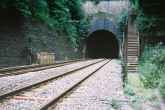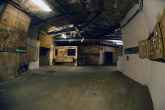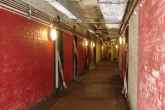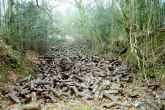Box Tunnel
November 01, 2010 2:10 PM

A two mile long tunnel, built by Isambard Kingdom Brunel through Box Hill. Next to the eastern entrance of the tunnel you can see the remains of a branch from the main London to Bristol railway line which lead into the hillside into the Corsham Ammunitions Depot and terminated at a half-mile long underground railway station which was used during World War II.
Corsham, Wiltshire, United Kingdom
Grid Reference: ST866695
No Access
This is a busy railway line, which means there is risk of death or a fine if you should try to enter. Note, there is no quarry access from the tunnel.
Last Updated: July 20, 2017 10:14 AM
Box Tunnel History
A two mile long tunnel, built by Isambard Kingdom Brunel through Box Hill. Next to the eastern entrance of the tunnel you can see the remains of a branch from the main London to Bristol railway line which lead into the hillside into the Corsham Ammunitions Depot and terminated at a half-mile long underground railway station which was used during World War II.
The village of Box was put on the map in 1836 when the famous Victorian engineer Isambard Kingdom Brunel was contract to build the Great Western Railway line. In order to complete the railway it was necessary to tunnel through Box Hill, a task which many said was impossible.
Local men were put to work from the village, roughly 4000 in all and using a ton of candles and a ton of gun powder a week they slowly blasted their way through the hill, the operation cost £100 for every yard the workforce advanced.
Fourteen air shafts were sunk along the alignment of the tunnel, this varied in depth from 70 to 300 feet, the shafts acted as access and bases from which the excavation was carried out. Seven of the 30 foot in diameter shafts still remain today as ventilation for the tunnel.
After five years of building and after claiming the lives of 100 men, the tunnel opened without any ceremony on 30th June 1841, it was at the time the longest railway tunnel in existence at almost two miles long.
The tunnel is dead straight and descends on a 1 in 100 gradient from the east. Apparently, on Brunel's birthday, April 15th, due to it's alignment, it is possible to see the sun shining through the entire length of the tunnel.
As the workforce made their way through Box Hill they became aware of the endless seams of Bath stone in the hill, when the tunnel opened and the men were put out of work some men opened new quarries in the area to extract the new source of Bath stone.
Next to the tunnel entrance at the eastern end a secondary tunnel was driven in to the hill side, this served the stone quarry. The entrance was adapted to accept a standard gauge railway line and an extra line was laid along side the main line to Corsham station, this enable the quarry men to load the stone straight on to train at an underground loading platform and move it to their stone yard near Corsham station, from here the stone could be transported across the country easily.
Part of the stone quarry were acquired and converted by the war department and converted for use in various war time roles, the huge Tunnel Quarry complex became the Central Ammunitions Depot making use of the branch line next to Box Tunnel. The entrance was changed to accept a more modern diesel train rather than the steam trains used in the quarrying days and a large underground station was constructed with two platforms so that the vital stocks could be loaded and unloaded in a secure environment.
The entrance to the ammunitions depot can still be seen, although securely boarded shut, along side the main railway line today.
Featured Urban Exploration Locations
Daily Horoscopes
You May Also Like


























